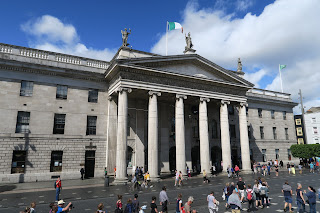Dublin is Ireland’s capital and largest city, with a population of approximately 1.3 million people. It is a city with an enormous amount of history - Dublin celebrated its ‘official’ millennium in 1988, meaning the Irish government recognized 988 as the year in which the city was settled and that this first settlement would later become the city of Dublin. It is however now thought that this first Viking settlement of about 841 was preceded by a Christian ecclesiastical settlement known as Duibhlinn. It is also a city that has seen its fair share of difficulties too - from the many Viking raids of the 9th and 10th centuries; the Act of Union (in 1801) when Ireland was formally united with Britain causing extreme economic turmoil, and the Great Hunger (Potato Famine) from 1845-1851. During the 20th century, the Easter Rising of 1916; the Irish War of Independence and the subsequent Irish Civil War resulted in a significant amount of physical destruction in Dublin. Dublin was also a victim of the Northern Irish Troubles when the Ulster Volunteer Force bombed Dublin.
The 21st century has seen enormous change to the landscape of Dublin. The city was at the forefront of Ireland’s economic expansion during the Celtic Tiger period but then was hit hard by the world-wide economic recession. There’s no doubt Dublin is recovering...but recuperation has been slow.
This summer’s trip started with a few days in Dublin, giving myself time to explore the city and deal with any jet-lag, which thankfully wasn’t an issue at all. Dublin has many places of interest and I’ll highlight a few in a couple of blog posts.
The Old Library of Trinity College, holding the Book of Kells, is one of the city’s most visited sites. The Book of Kells is an illustrated manuscript created by Irish monks circa 800 AD. It is one of the greatest treasures of medieval Europe, written in Latin, and containing the four gospels of the New Testament together with various tests and tables. The pages are made from vellum (calf-skin prepared for writing) and it once had a jewelled cover called a ‘cumdach’ (book-shrine) but this was stolen in 1007 AD. Not surprisingly, you can’t take photos of the Book of Kells but the building that houses the Book of Kells is pretty spectacular too!
The Book of Kells is housed in the Old Library of Trinity College, and the second floor is what’s known as The Long Room. Built between 1712 and 1732, it is nearly 65 metres in length and filled with over 200,000 of the Library’s oldest books. The barrel-vaulted ceiling was added in 1860 to allow space for more books when the existing shelves became full. Lining the central walkway of the Long Room are marble busts of famous philosophers and writers. The Long Room is a fully functioning library and still in use today.
Sphere Within Sphere sculpture outside the Berkeley Library
This 30m-high Campanile dominates the main entrance into Trinity College. It was erected in 1852.
The Old Library, housing the Book of Kells is on the right.
Ha’penny Bridge, built in 1816, one of the world’s oldest cast-iron bridges
Dublin is also a lovely city just to walk around, enjoy the architecture...and the energy.
Temple Bar Pub ... complete with James Joyce
Wellington Monument in Phoenix Park
The Clarence Hotel - owned by Bono
The Garden of Remembrance - dedicated to all those who gave their lives in the cause of Irish freedom
The General Post Office...at the heart of Ireland’s struggle for independence, it served as command HQ for the rebels during the Easter Rising of 1916.
Custom House (1781-1791)
Leinster House - built between 1745-1748
Oscar Wilde
Famine Memorial - designed to commemorate the ravages of the Great Hunger (1845-51). The location of these sculptures is where, in 1846, one of the first ‘coffin ships’ set sail for the USA.
Definitely something to love ... when the bar (pub) is full, the Irish just take their drinks outside!













































No comments:
Post a Comment